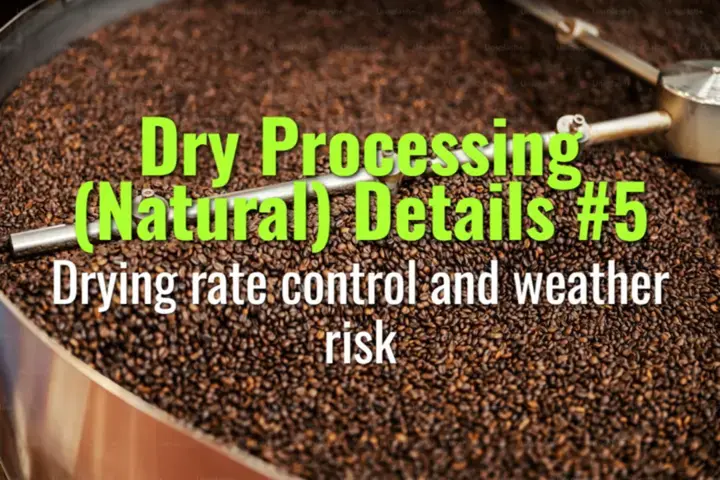Drying rate control and weather risk
This topic explains how controlling the drying rate and managing weather risks are essential in natural (dry) coffee processing to ensure stability, flavor quality, and defect prevention.
- Coffee Basics Nerds
- 2 min read
Article 5 of 12 in Dry Processing (Natural) Details/

Why Drying Rate Matters
- Natural coffees dry with skin and pulp intact → high sugar and moisture levels.
- If drying is too fast, outer layers harden while inner bean stays wet (case hardening).
- If drying is too slow, cherries ferment excessively or mold develops.
Optimal Drying Rate
- Target: Reduce moisture from ~55–60% (fresh cherry) to 10–12% (safe storage).
- Ideal duration: 15–30 days, depending on climate.
- Balanced drying preserves sweetness, fruit notes, and bean integrity.
Weather Risks in Natural Processing
- Rain: Re-wets cherries, causing mold or unwanted fermentation.
- Excessive sun/heat: Leads to cracking, uneven drying, or baked flavors.
- Humidity: Slows drying, increasing risk of mold growth.
- Wind: Can accelerate drying unevenly or scatter cherries.
Strategies for Drying Rate Control
- Layer Thickness: Keep cherries in layers 3–5 cm deep for uniform drying.
- Turning Schedules: Frequent turning in early days, tapering off later.
- Shade & Covers: Shade nets or plastic covers regulate excessive heat/sun.
- Solar Dryers & Tunnels: Protect cherries from rain and provide controlled airflow.
- Moisture Tracking: Use meters to monitor progress and avoid case hardening.
Weather Risk Mitigation
- Rain protection: Move cherries under shelter or cover with tarps.
- Climate planning: Time harvests around expected dry seasons.
- Hybrid drying: Combine sun-drying with mechanical dryers during unstable weather.
Quality Impacts
- Controlled drying: Produces clean, fruity, and stable naturals with long shelf life.
- Uncontrolled drying: Leads to earthy, moldy, or flat cups, downgraded quality.
Lasting Importance
Drying rate control and weather risk management are critical to the success of natural processing. With proper protocols, farmers can safeguard against climate variability and deliver consistent, high-quality coffees valued in specialty markets.
You might also like:
- Tags:
- Lasting Importance
- Shelf Life
- High Quality
- Specialty Markets
- Uneven Drying
- Natural Processing
- Risk Management
- Solar Dryers
- Mechanical Dryers
- Risk Mold
- Mold Growth
- Quality Impacts
- Dry Seasons
- Frequent Turning
- Deliver Consistent
- Consistent High
- High Sugar
- Skin Pulp
- Safe Storage
- Shade Nets
- Quality Lasting
- Climate Variability
- Drying Leads
- Excessive Heat
- Bean Integrity
- Moisture Levels
- Slows Drying
- Uniform Drying
- Fruit Notes
- Sweetness Fruit
- Sun Drying
- Dryers Tunnels